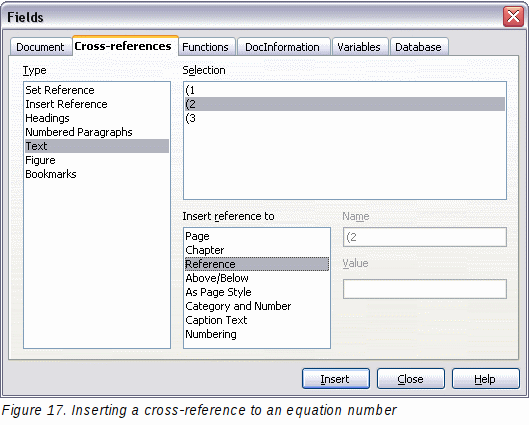

Getting Started Guide
Chapter
9
Getting Started with Math
LibreOffice's Equation Editor
This document is Copyright © 2010 by its contributors as listed below. You may distribute it and/or modify it under the terms of either the GNU General Public License (http://www.gnu.org/licenses/gpl.html), version 3 or later, or the Creative Commons Attribution License (http://creativecommons.org/licenses/by/3.0/), version 3.0 or later.
All trademarks within this guide belong to their legitimate owners.
Contributors
Ron Faile Jr.
Feedback
Please direct any comments or suggestions about this document to: documentation@libreoffice.org
Acknowledgments
This chapter is based on Chapter 9 of Getting Started with OpenOffice.org. The contributors to that chapter are:
Daniel
Carrera
Agnes Belzunce
Peter Kupfer
Ian Laurenson
Janet
M. Swisher
Jean Hollis Weber
Publication date and software version
Published 30 December 2010. Based on LibreOffice 3.3.
Some keystrokes and menu items are different on a Mac from those used in Windows and Linux. The table below gives some common substitutions for the instructions in this chapter. For a more detailed list, see the application Help.
|
Windows/Linux |
Mac equivalent |
Effect |
|
Tools → Options menu selection |
LibreOffice → Preferences |
Access setup options |
|
Right-click |
Control+click |
Opens a context menu |
|
Ctrl (Control) |
z (Command) |
Used with other keys |
|
F5 |
Shift+z+F5 |
Opens the Navigator |
|
F11 |
z+T |
Opens the Styles & Formatting window |
Contents
Formula editor as a floating window 10
How can I make a formula bigger? 11
Equations over more than one line 12
How do I add limits to my sum/integral? 12
How do I make a derivative? 13
Math is LibreOffice’s component for writing mathematical equations. It is most commonly used as an equation editor for text documents, but it can also be used with other types of documents or stand-alone. When used inside Writer, the equation is treated as an object inside the text document.
|
Note |
The equation editor is for writing equations in symbolic form, as in equation 1. If you want to evaluate a numeric value, see the Calc Guide. |
|
|
(1) |
To insert an equation, choose Insert → Object → Formula.
The equation editor opens at the bottom of the screen, and the floating Elements window may appear. You will also see a small box with a gray border in your document, where the formula will be displayed.
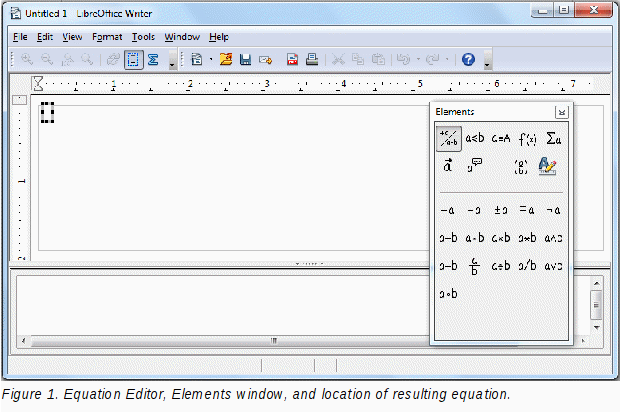
The
equation editor uses a markup language to represent formulas. For
example, %beta
creates the Greek character beta (![]() ).
This markup is designed to read similar to English whenever possible.
For example, a
over b
produces a fraction:
).
This markup is designed to read similar to English whenever possible.
For example, a
over b
produces a fraction:
![]() .
.
You can enter a formula in three ways:
Select a symbol from the Elements window.
Right-click on the equation editor and select the symbol from the context menu.
Type markup in the equation editor.
The context menu and the Elements window insert the markup corresponding to a symbol. This provides a convenient way to learn the Math markup.
|
Note |
Click on the document body to exit the formula editor. Double-click on a formula to enter the formula editor again. |
The simplest method for entering a formula is to use the Elements window.
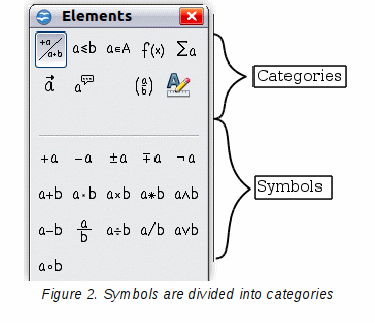
The Elements window is divided into two main parts.
The top shows the symbol categories. Click on these to change the list of symbols.
The bottom shows the symbols available in the current category.
|
Tip |
You can hide or show the Elements window with View → Elements. |
Example 1:![]()
For
this example we will enter a simple formula:![]() .
On the Elements window:
.
On the Elements window:
Select the top-left button of the categories (top) section.
Click on the multiplication symbol.
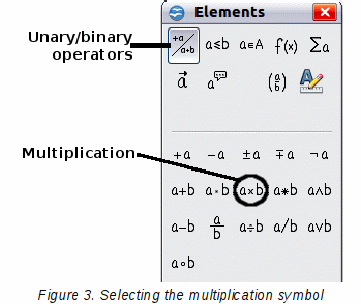
When you select the multiplication symbol on the Elements window, two things happen:
The
equation editor shows the markup:![]()
The
body of the document shows a gray box like this:![]()
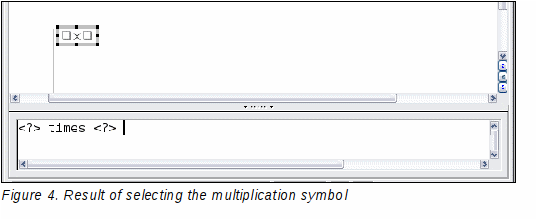
The <?> symbols shown in Figure 4 are placeholders that you can replace by other text, for example 5 and 4. The equation will update automatically, and the result should resemble Figure 5.
|
Tip |
To keep the equation from updating automatically, choose View → AutoUpdate display from the menu bar. To update a formula manually, press F9 or choose View → Update. |
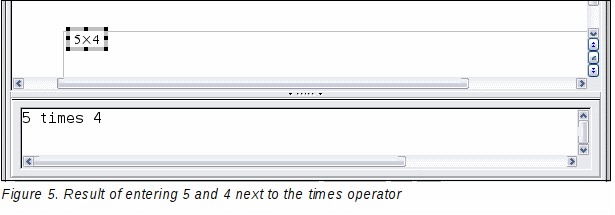
Another way to access mathematical symbols is to right-click on the equation editor. This pops up the menu shown in Figure 6. The items in this menu correspond exactly to those in the Elements window.
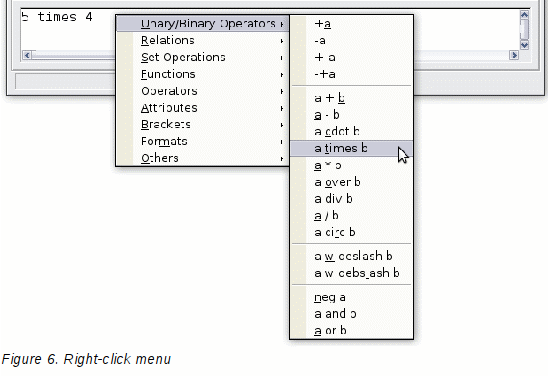
You
can type the markup directly in the equation editor. For example, you
can type 5
times 4 to obtain
![]() .
If you know the markup, this can be the fastest way to enter a
formula.
.
If you know the markup, this can be the fastest way to enter a
formula.
|
Tip |
The formula markup resembles the way the formula reads in English. |
Below is a short list of common equations and their corresponding markup.
|
Display |
Command |
Display |
Command |
|
|
a = b |
|
sqrt {a} |
|
|
a^2 |
|
a_n |
|
|
int f(x) dx |
|
sum a_n |
|
|
a <= b |
|
infinity |
|
|
a times b |
|
x cdot y |
Greek
characters (![]() ,
and so on) are common in mathematical formulas. These
characters are not available in the Elements window or on the
right-click menu. Fortunately, the markup for Greek
characters is simple: Type a % sign followed the name of the
character, in English. (In localized versions of LibreOffice, these
names are localized.)
,
and so on) are common in mathematical formulas. These
characters are not available in the Elements window or on the
right-click menu. Fortunately, the markup for Greek
characters is simple: Type a % sign followed the name of the
character, in English. (In localized versions of LibreOffice, these
names are localized.)
To write a lowercase character, type the name of the character in lowercase.
To write an uppercase character, type the name of the character in uppercase.
See the table below for some examples.
|
Lowercase |
Uppercase |
|
%alpha |
%ALPHA |
|
%beta
|
%BETA
|
|
%gamma |
%GAMMA |
|
%psi
|
%PSI
|
|
%phi
|
%PHI
|
|
%theta |
%THETA |
|
Note |
A complete table of Greek characters is provided in the Math Guide. |
Another way to enter Greek characters is by using the Symbols catalog window. Choose Tools → Catalog. Under Symbol set, select Greek and double-click on a Greek letter from the list. The markup name of the character is shown below the list window.
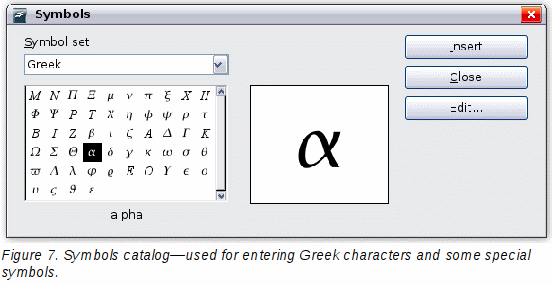
Example 2:![]()
![]()
For this example we will suppose that:
We want to enter the above formula (the value of pi rounded to 5 decimal places).
We know the name of the Greek character (pi).
But
we do not know the markup associated with the
![]() symbol.
symbol.
Step
1: Type %
followed by the text pi.
This displays the Greek character
![]() .
.
Step 2: Open the Elements window (View → Elements).
Step
3: The
![]() symbol is a relation, so we click on the Relations button. If you
hover the mouse over this button you see the tooltip Relations
(Figure 8).
symbol is a relation, so we click on the Relations button. If you
hover the mouse over this button you see the tooltip Relations
(Figure 8).
Figure 9 shows the Elements window after clicking the Relations button. The symbol we want is circled.
|
Figure 8. Tooltip indicates the Relations button |
Figure 9. After selecting Relations |
Step
4: Click on the a![]() b
symbol. The equation editor now shows the markup %pi<?>
simeq <?>.
b
symbol. The equation editor now shows the markup %pi<?>
simeq <?>.
Step 5: Delete the <?> text and add 3.14159 at the end of the equation. We end up with the markup %pi simeq 3.14159. The result is shown in Figure 10.
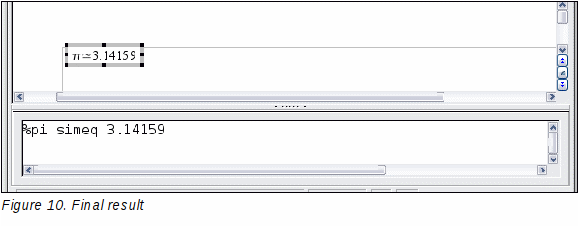
Formula editor as a floating window
The formula editor can cover a large part of the Writer window. To turn the formula editor into a floating window, do this:
Hover the mouse over the editor frame, as shown in Figure 11.
Hold down the Control key and double-click.
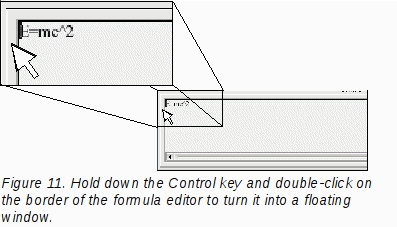
Figure 12 shows the result. You can dock the floating window again by using the same steps. Hold down the Control key and double-click the window frame.
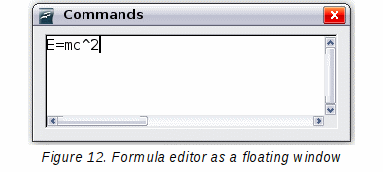
How can I make a formula bigger?
This is one of the most common questions people ask about Math. The answer is simple:
Start the formula editor and choose Format → Font size.
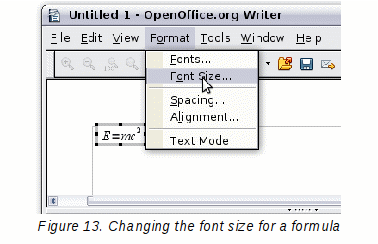
Select a larger font size under Base size (top-most entry).
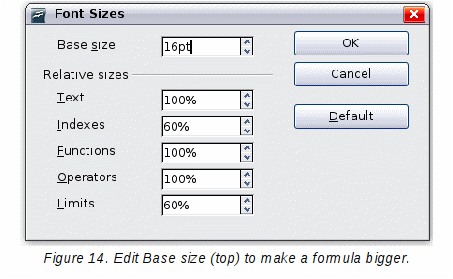
The result of this change is illustrated in Figure 15.

The most difficult part of using Math comes when writing complicated formulas. This section provides some advice.
Math knows nothing about order of operation. You must use brackets to state the order of operations explicitly. Consider the following example.
|
Markup |
Result |
|
2 over x + 1 |
|
|
2 over {x + 1} |
|
Equations over more than one line
Suppose
you want to type an equation covering more than one line. For
example:![]()
Your first reaction would be to simply press the Enter key. However, if you press the Enter key, though the markup goes to a new line, the resulting equation does not. You must type the newline command explicitly. This is illustrated in the table below.
|
Markup |
Result |
|
x = 3 y = 1 |
|
|
x = 3 newline y = 1 |
|
How do I add limits to my sum/integral?
The sum and int commands can (optionally) take the parameters from and to. These are used for lower and upper limits respectively. These parameters can be used singly or together. Limits for integrals are usually treated as subscripts and superscripts.
|
Markup |
Result |
|
sum from k = 1 to n a_k |
|
|
int from 0 to x f(t) dt or int_0^x f(t) dt |
|
|
int from Re f |
|
|
sum to infinity 2^{-n} |
|
|
Note |
For more details on integrals and sums, see the Math Guide. |
For background, we start with an overview of the matrix command.
|
Markup |
Result |
|
matrix { a # b ## c # d } |
|
|
Note |
Rows are separated by two #’s and entries within each row are separated by one #. |
The first problem people have with matrices is that brackets do not scale with the matrix.
|
Markup |
Result |
|
( matrix { a # b ## c # d } ) |
|
Math provides scalable brackets. That is, the brackets grow in size to match the size of their contents. Use the commands left( and right) to make scalable brackets.
|
Markup |
Result |
|
left( matrix { a # b ## c # d } right) |
|
|
Tip |
Use left[ and right] to obtain square brackets. |
Making derivatives essentially comes down to one trick: Tell Math it’s a fraction.
In other words, you have to use the over command. Combine this with either the letter d (for a total derivative) or the partial command (for a partial derivative) to achieve the effect of a derivative.
|
Note |
Notice that we have to use braces (squiggly brackets) to make the derivative. |
|
Markup |
Result |
|
{df} over {dx} |
|
|
{partial f} over {partial y} |
|
|
{partial^2 f} over {partial t^2} |
|
How do I align my equations at the equals sign?
Math does not have a command for aligning equations on a particular character, but you can use a matrix to do this, as shown below.
|
Markup |
Result |
|
matrix{ alignr x+y # {}={} # alignl 2 ## alignr x # {}={} # alignl 2-y } |
|
The empty braces around = are necessary because = is a binary operator and thus needs an expression on each side.
You can reduce the spacing around = if you change the inter-column spacing of the matrix:
With the equation editor open, choose Format → Spacing from the menu bar.
In the Spacing dialog (Figure 16), click the Category button and select Matrices in the drop-down menu.
Enter 0% for Column spacing and click OK.
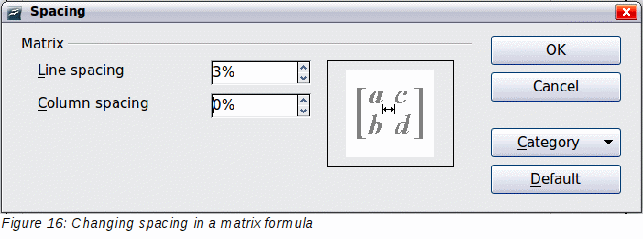
Equation numbering is one of Math’s best hidden features. The steps are simple:
Start a new line.
Type fn and then press F3.
The fn is replaced by a numbered formula:
|
|
(2) |
Now you can double-click on the formula to edit it. For example, here is the Riemann Zeta function:
|
|
(3) |
You can reference an equation (“as shown in Equation (2)”) with these steps:
Choose Insert → Cross-reference from the menu bar.
On the Cross-references tab (Figure 17), under Type, select Text.
Under Selection, select the equation number.
Under Format, select Reference.
Click Insert.
Done! If you later add more equations to the paper before the referenced equation, all the equations will automatically renumber and the cross-references will update.
|
Tip |
To insert the equation number without parenthesis around it, choose Numbering instead of Reference under Format. |
